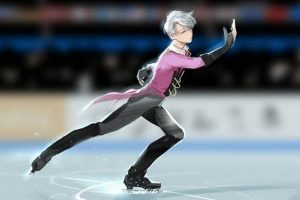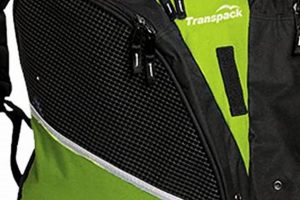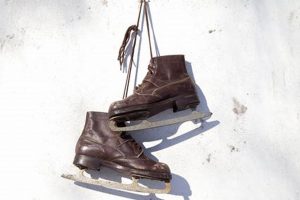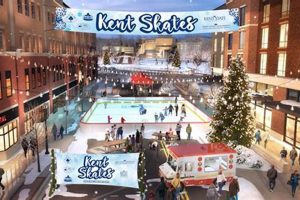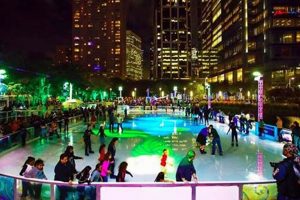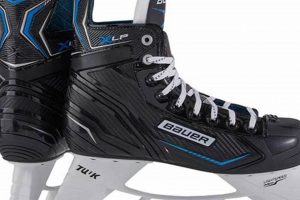The action of ensuring ice skate blades possess a keen edge is a necessary aspect of maintaining optimal performance on the ice. Dull blades can significantly impact a skater’s ability to glide, turn, and stop effectively, leading to decreased control and potential safety hazards. Finding a local service that provides this maintenance is crucial for any skater, regardless of skill level.
Proper blade maintenance enhances a skater’s overall experience, allowing for smoother movements and greater confidence. A sharp edge provides the necessary grip on the ice, facilitating precision and responsiveness. Historically, skate sharpening was a skill often performed by blacksmiths or experienced skaters; today, specialized equipment and trained technicians ensure consistent and accurate results.
Locating accessible and reliable skate sharpening services involves several avenues, encompassing local sporting goods stores, ice rinks, and specialized skate shops. Assessing the quality of service and understanding the different sharpening techniques available are essential considerations for skaters seeking to optimize their equipment.
Optimizing Skate Blade Maintenance
Ensuring correctly sharpened ice skate blades involves several critical considerations for skaters seeking peak performance and safety. A proactive approach to blade care extends the lifespan of the skates and enhances the overall skating experience.
Tip 1: Assess Blade Condition: Before seeking a sharpening service, carefully examine the blades for visible damage, such as deep nicks or excessive rust. Significant damage may require more extensive repair or blade replacement rather than a simple sharpening.
Tip 2: Research Local Service Providers: Investigate local sporting goods stores, ice rinks, and specialized skate shops to identify potential sharpening services. Consider factors such as experience, equipment used, and customer reviews when evaluating providers.
Tip 3: Inquire About Sharpening Techniques: Different sharpening techniques exist, each producing a slightly different edge profile. Discuss the skater’s skill level and skating style with the technician to determine the most appropriate sharpening method. Traditional hollow grinding is a common technique; however, alternatives might be better suited for specific needs.
Tip 4: Understand the “Radius of Hollow” (ROH): The ROH refers to the curvature ground into the blade, directly impacting grip and glide. A smaller ROH creates a sharper edge with more grip, while a larger ROH provides a smoother glide with less grip. Determine the optimal ROH based on personal preference and skating discipline.
Tip 5: Establish a Regular Sharpening Schedule: The frequency of sharpening depends on usage and ice conditions. As a general guideline, competitive skaters may require sharpening after every few sessions, while recreational skaters can sharpen less frequently. Consistent blade inspection helps determine the appropriate schedule.
Tip 6: Protect Blades After Sharpening: Always use blade guards when walking off the ice to prevent damage from abrasive surfaces. Dry the blades thoroughly after each use to prevent rust formation. Consider using a moisture-absorbing blade cover for storage.
Tip 7: Seek Professional Advice: Consult with a qualified skating coach or experienced skate technician to gain personalized recommendations on blade care and sharpening techniques. Their expertise can help optimize blade performance and extend their lifespan.
Adhering to these recommendations contributes to a superior skating experience and ensures optimal blade performance. Prioritizing blade maintenance translates to enhanced control, improved safety, and prolonged equipment longevity.
The following sections will explore the specific types of services available and the criteria for choosing the optimal service provider.
1. Local Sporting Goods
Local sporting goods stores often serve as a readily accessible resource for ice skate sharpening services. The cause-and-effect relationship is straightforward: the demand for ice skates generates a parallel demand for skate maintenance, prompting sporting goods retailers to offer sharpening services. The importance of these stores within the context of locating skate sharpening services stems from their prevalence and convenient locations, especially in areas where ice skating is a popular activity. For example, a large chain sporting goods retailer may provide skate sharpening as part of its equipment maintenance offerings, catering to both casual and serious skaters.
However, the quality of sharpening services at sporting goods stores can vary considerably. While some employ trained technicians and utilize advanced sharpening equipment, others may offer less specialized service. A crucial factor is the expertise of the staff and the specific sharpening equipment available. For instance, a store primarily focused on hockey equipment is more likely to possess the specialized knowledge and tools needed for hockey skate sharpening compared to a general sporting goods store. Therefore, skaters should inquire about the technician’s experience and the types of sharpening techniques employed before entrusting their skates.
In summary, local sporting goods stores provide a convenient avenue for accessing skate sharpening services, but the quality and expertise can differ significantly. Skaters should exercise due diligence in assessing the store’s capabilities and the technician’s qualifications to ensure optimal blade maintenance. The practical significance of this understanding lies in making informed decisions about where to get skates sharpened, balancing convenience with the need for quality service that meets specific skating requirements.
2. Ice Rink Pro Shops
Ice rink pro shops represent a key resource for skate sharpening services, directly associated with the environment where skating occurs. The proximity of these shops to the ice surface provides skaters with convenient access to maintenance and repair services, establishing them as a primary option when considering “where to get ice skates sharpened near me”.
- Expertise and Specialization
Pro shops located within ice rinks typically employ technicians with specialized knowledge in skate maintenance, particularly for the disciplines practiced at the rink. For instance, a rink primarily hosting hockey leagues will likely have technicians experienced in sharpening hockey skates to meet specific performance demands, offering an advantage over general sporting goods stores.
- Direct Feedback Loop
The close interaction between skaters, coaches, and pro shop technicians fosters a valuable feedback loop. Technicians can observe skaters’ performance and adjust sharpening techniques to optimize blade characteristics based on individual needs and skating styles. This iterative process ensures a tailored approach to blade maintenance, directly enhancing the skater’s experience.
- Equipment and Technology
Ice rink pro shops frequently invest in high-quality sharpening equipment and stay abreast of current technological advancements in blade maintenance. This commitment to precision ensures accurate and consistent sharpening, minimizing the risk of damage or suboptimal performance. Access to specialized tools, such as radius gauges and profiling equipment, further enhances the quality of service.
- Community Integration
Pro shops often serve as hubs within the skating community, offering a platform for skaters to connect, share information, and seek advice. This integration allows technicians to gain a deeper understanding of the skaters’ needs and preferences, leading to more personalized and effective service. The presence of a pro shop within a rink fosters a culture of blade maintenance awareness and encourages skaters to prioritize equipment care.
In essence, ice rink pro shops offer a blend of expertise, direct feedback, advanced equipment, and community integration that positions them as a valuable resource for skaters seeking reliable sharpening services. Choosing a pro shop for blade maintenance provides access to specialized knowledge and tailored techniques, contributing to enhanced performance and safety on the ice. This direct link to the skating environment ensures services align with the specific needs of skaters within that context, solidifying the pro shop’s relevance as a prime answer to “where to get ice skates sharpened near me”.
3. Specialized Skate Retailers
Specialized skate retailers occupy a niche position in the market, offering focused expertise and services tailored to specific skating disciplines. This specialization significantly influences their relevance when considering “where to get ice skates sharpened near me,” making them a potentially superior option for skaters seeking nuanced blade maintenance.
- Discipline-Specific Knowledge
These retailers possess in-depth knowledge of the unique demands of different skating styles, such as figure skating, hockey, or speed skating. Technicians understand the specific blade profiles, radius of hollow, and sharpening techniques optimal for each discipline. For instance, a retailer specializing in figure skating will be adept at creating the precise rocker and spin radius required for complex jumps and spins, a level of precision not always available at general sporting goods stores. The implications of this expertise directly impact performance, ensuring skaters receive sharpening aligned with their specific needs.
- High-End Equipment and Techniques
Specialized retailers often invest in advanced sharpening equipment and employ cutting-edge techniques to achieve superior results. This may include computerized sharpening machines, laser blade analysis, and custom profiling tools. The use of such technology allows for precise replication of blade profiles and consistent sharpening across multiple sessions. For example, some retailers offer blade profiling services that tailor the blade shape to the skater’s individual biomechanics, optimizing glide and edge control. Access to such advanced equipment sets these retailers apart and underscores their value in providing high-quality sharpening.
- Customization and Personalization
Beyond standard sharpening, specialized retailers often offer a range of customization options, including blade contouring, pitch adjustments, and custom radius of hollow grinding. These services allow skaters to fine-tune their blades to match their personal preferences and skating style. For example, a skater experiencing excessive edge bite may benefit from a modified blade profile that reduces the aggressiveness of the edges. The ability to personalize blade characteristics enhances performance and comfort, making specialized retailers an attractive option for serious skaters.
- Expert Consultation and Advice
These retailers typically employ knowledgeable staff who can provide expert consultation on blade maintenance, sharpening frequency, and blade selection. They can assess a skater’s technique, analyze their blade wear patterns, and recommend appropriate sharpening strategies. For example, a technician may advise a skater to adjust their radius of hollow based on ice conditions or skating goals. The availability of expert advice empowers skaters to make informed decisions about blade care and optimize their skating performance. The value of this consultative approach cannot be overstated when considering optimal sharpening solutions.
In conclusion, specialized skate retailers offer a compelling combination of discipline-specific knowledge, advanced equipment, customization options, and expert consultation, making them a prime choice for discerning skaters prioritizing optimal blade performance. While potentially more expensive than general options, the enhanced quality and personalized service often justify the investment. Their focus on specific skating disciplines ensures a level of expertise not readily available elsewhere, solidifying their place as a key consideration in addressing “where to get ice skates sharpened near me.”
4. Technician Experience Matters
The selection of a skate sharpening service hinges significantly on the experience level of the technician performing the work. The correlation between technician expertise and the quality of the sharpening directly impacts a skater’s performance, safety, and overall skating experience. Locating “where to get ice skates sharpened near me” necessitates evaluating the personnel performing the service. An inexperienced technician may incorrectly grind the blade, altering the intended radius of hollow or creating an uneven edge. This can lead to decreased control, difficulty executing turns, and increased risk of falls. A practical example includes a skater experiencing unexpected slippage after a sharpening, traced back to an improperly ground blade by an inexperienced technician. Therefore, technician experience is not merely a desirable attribute, but a critical determinant of service quality.
Verifying a technician’s experience involves several avenues. Requesting information on their training, certifications, and years of experience is essential. Further investigation may include inquiring about the types of skates they have sharpened and seeking references from other skaters or coaches. A seasoned technician will possess a thorough understanding of different blade types, sharpening techniques, and the impact of blade geometry on skating performance. This knowledge allows them to customize the sharpening process to meet the individual needs of each skater. For example, a figure skater requires a different blade profile and edge sharpness than a hockey player. An experienced technician will recognize these distinctions and adjust their approach accordingly.
In summary, when determining “where to get ice skates sharpened near me,” prioritizing technician experience is paramount. The consequences of entrusting skates to an unqualified individual range from suboptimal performance to potential injury. By verifying credentials, seeking recommendations, and assessing the technician’s knowledge, skaters can make informed decisions and ensure their skates are sharpened to the highest standards. This emphasis on expertise directly contributes to enhanced control, improved safety, and a more enjoyable skating experience.
5. Sharpening Equipment Quality
The quality of skate sharpening equipment is a crucial determinant when evaluating potential service providers. The accuracy and consistency of blade sharpening are directly dependent on the precision and condition of the equipment used. Identifying “where to get ice skates sharpened near me” requires careful consideration of the technology employed in the process.
- Precision Grinding Wheels
The grinding wheel constitutes a core component of skate sharpening equipment. High-quality wheels maintain a consistent grit size and composition, ensuring a uniform edge along the blade. Worn or uneven wheels can produce inconsistent results, leading to variations in the radius of hollow or uneven edge sharpness. For example, a grinding wheel with embedded debris can create scratches or imperfections on the blade surface, negatively impacting glide and control. The utilization of precision grinding wheels is thus essential for achieving optimal blade performance.
- Automated Sharpening Systems
Automated sharpening systems offer increased precision and consistency compared to manual methods. These systems utilize computer-controlled grinding processes to maintain accurate blade profiles and radius of hollow. The automation minimizes the potential for human error, ensuring reproducible results across multiple sharpenings. An example is a computerized sharpening machine that automatically adjusts the grinding parameters based on the selected skate type and skater preference. This level of automation is valuable for maintaining consistent performance over time.
- Profiling and Measurement Tools
Accurate profiling and measurement tools are critical for assessing blade geometry and ensuring proper alignment. Devices such as radius gauges and blade profiling templates enable technicians to verify the accuracy of the sharpening process and make necessary adjustments. The lack of such tools can lead to misalignment or inconsistencies in the blade profile, impacting balance and control. For example, a technician using a radius gauge can precisely measure the curvature of the blade and adjust the sharpening process to achieve the desired radius of hollow. These tools are essential for achieving customized and accurate sharpening results.
- Maintenance and Calibration
Regular maintenance and calibration of sharpening equipment are essential for ensuring consistent performance. Properly maintained equipment operates within specified tolerances, minimizing the risk of errors or inconsistencies. Neglecting maintenance can lead to inaccurate readings, worn components, and suboptimal sharpening results. An example would be regularly truing the grinding wheel to ensure a flat and even surface, preventing uneven grinding. Commitment to equipment maintenance is indicative of a provider’s dedication to quality service.
In conclusion, the quality of sharpening equipment directly influences the accuracy and consistency of skate sharpening services. When researching “where to get ice skates sharpened near me,” skaters should inquire about the type of equipment used and the maintenance protocols in place. Choosing a provider that invests in high-quality equipment and prioritizes its upkeep is crucial for achieving optimal blade performance and maximizing the skating experience. A focus on these factors will lead to improved control, enhanced safety, and prolonged blade life.
6. Blade Care Practices
The longevity and performance of ice skate blades are inextricably linked to consistent and appropriate care practices. This relationship has a direct bearing on the frequency and necessity of professional sharpening services, thereby influencing the selection of “where to get ice skates sharpened near me”. Proactive blade maintenance minimizes damage, reduces rust formation, and preserves the edge quality, potentially extending the intervals between required sharpenings.
- Drying Blades After Use
Moisture is a primary catalyst for rust formation, which degrades blade edges and necessitates more frequent sharpening. Thoroughly drying blades immediately after each skating session is crucial. This involves using a soft, absorbent cloth to remove all traces of moisture from the blade surface and the blade holder. Failure to dry blades adequately accelerates corrosion, requiring more aggressive sharpening techniques to restore the edge, ultimately shortening the blade’s lifespan. Consequently, selecting a sharpening service becomes more frequent and pressing if proper drying practices are neglected.
- Using Blade Guards When Off-Ice
Walking on unprotected skate blades, even for short distances, exposes them to abrasive surfaces like concrete or rubber flooring. This abrasion dulls the edges and can cause nicks or gouges. Consistent use of hard blade guards when walking off the ice is essential for protecting the blade edges. Selecting a sharpening service that offers blade profiling to repair damage from off-ice wear becomes relevant if blade guards are not used consistently. Furthermore, selecting a location that understands the effect of off-ice wear on blade geometry is crucial.
- Proper Blade Storage
During periods of non-use, improper storage can contribute to rust formation and blade damage. Storing skates in a dry environment with moisture-absorbing blade covers helps to prevent corrosion. Avoid storing skates in enclosed bags or containers where moisture can accumulate. The selection of blade covers becomes relevant as proper blade covers contribute to the minimization of damage. Utilizing moisture-wicking soakers that allow air circulation minimizes the formation of rust during periods of disuse.
- Regular Blade Inspection
Periodic inspection of blade edges allows for early detection of damage or wear. Identifying minor imperfections before they escalate can prevent the need for more extensive sharpening or repairs. Regular inspection involves visually examining the blade edges for nicks, burrs, or signs of rust. Addressing minor issues promptly, such as using a honing stone to remove small burrs, can extend the time between professional sharpenings. Understanding the signs of wear and damage enables skaters to make informed decisions about when to seek professional sharpening services, influencing the selection of “where to get ice skates sharpened near me” based on the identified needs.
In conclusion, consistent adherence to proper blade care practices minimizes the need for frequent sharpening, reducing the urgency in determining “where to get ice skates sharpened near me”. While professional sharpening remains a necessary part of skate maintenance, proactive blade care prolongs the life of the blades and optimizes skating performance. Neglecting these practices necessitates more frequent and potentially more aggressive sharpening, underscoring the importance of integrating proper care into a skater’s routine.
7. Radius of Hollow Variation
The “radius of hollow” (ROH) profoundly influences the performance characteristics of ice skate blades. The ROH defines the curvature ground into the blade’s bottom surface, dictating the sharpness of the edges and, consequently, the amount of grip on the ice. A smaller ROH creates deeper, sharper edges, providing increased bite for tighter turns and quicker stops. Conversely, a larger ROH produces shallower edges, promoting glide and reducing resistance. Therefore, selecting “where to get ice skates sharpened near me” is intrinsically linked to the service provider’s ability to accurately and consistently implement a desired ROH. For instance, a figure skater executing intricate jumps and spins typically benefits from a smaller ROH for enhanced edge control, whereas a hockey player prioritizing speed and maneuverability may prefer a larger ROH. The practical consequence of an incorrect ROH manifests as reduced control, increased fatigue, or an inability to perform specific skating maneuvers.
The ability of a sharpening service to offer a range of ROH options and to accurately reproduce a specific ROH setting is a critical factor in service selection. Experienced technicians utilize specialized gauges and equipment to measure and adjust the ROH, ensuring consistency across sharpenings. The impact of ROH variation extends to different ice conditions. Softer ice may require a larger ROH to prevent excessive edge penetration, while harder ice benefits from a smaller ROH for optimal grip. A skilled technician can advise skaters on the appropriate ROH based on their skating style, discipline, and prevailing ice conditions. Consider a scenario where a skater experiences difficulty maintaining edge control on freshly resurfaced ice; adjusting to a slightly larger ROH could mitigate this issue. Therefore, selecting “where to get ice skates sharpened near me” should involve assessing the service provider’s expertise in ROH adjustment and their ability to cater to individual needs.
In summary, the “radius of hollow” is a pivotal element of skate blade performance, and the selection of a skate sharpening service must consider the provider’s competence in ROH management. The availability of a range of ROH options, accurate measurement tools, and experienced technicians capable of advising on optimal settings are all essential considerations. By understanding the interplay between ROH variation and blade performance, skaters can make informed decisions about “where to get ice skates sharpened near me,” ultimately enhancing their control, efficiency, and overall skating experience. Addressing this nuance promotes optimized performance while mitigating potential safety concerns, reinforcing the crucial link between ROH and service provider selection.
Frequently Asked Questions
The subsequent questions address common concerns regarding ice skate sharpening, aiming to provide clarity on best practices and optimal service selection.
Question 1: What factors determine how frequently ice skates should be sharpened?
The frequency of skate sharpening is influenced by several variables, including skating frequency, ice hardness, and skating style. Competitive skaters who train daily may require sharpening as often as every few sessions, while recreational skaters may only need sharpening a few times per season. Harder ice surfaces tend to dull blades more quickly, necessitating more frequent sharpening. Skating style also plays a role; skaters who execute frequent jumps and turns place greater stress on the blade edges, requiring more frequent maintenance.
Question 2: How can the quality of a skate sharpening service be assessed before entrusting skates to a provider?
Assessing the quality of a skate sharpening service involves several steps. Requesting information on the technician’s experience and certifications is essential. Observing the equipment used, ensuring it is well-maintained and calibrated, is also crucial. Inquiring about the specific sharpening techniques employed and seeking references from other skaters or coaches can provide further insight. Furthermore, reading online reviews and checking the service provider’s reputation within the skating community is advisable.
Question 3: Is there a universal “radius of hollow” setting suitable for all skaters?
No singular “radius of hollow” setting is universally appropriate. The optimal ROH depends on individual skating style, discipline, and ice conditions. A smaller ROH provides increased edge grip, benefiting figure skaters and those requiring precise control. A larger ROH promotes glide and reduces resistance, favored by hockey players and speed skaters. Consulting with an experienced technician to determine the most suitable ROH based on individual needs is recommended.
Question 4: What are the potential consequences of using dull ice skate blades?
Skating with dull blades compromises control, increases fatigue, and elevates the risk of falls. Dull edges lack the necessary grip on the ice, making it difficult to execute turns and maintain balance. Compensating for dull blades requires expending more energy, leading to increased fatigue. Furthermore, the reduced control increases the likelihood of accidents and injuries. Maintaining sharp blades is paramount for safety and performance.
Question 5: Can damage to ice skate blades be repaired, or is blade replacement always necessary?
The feasibility of repairing damaged ice skate blades depends on the severity and location of the damage. Minor nicks and burrs can often be removed through professional sharpening and profiling. However, deep gouges, significant rust, or blade fractures may necessitate blade replacement. Consulting with an experienced skate technician to assess the damage and determine the most appropriate course of action is crucial.
Question 6: What are the essential steps for maintaining ice skate blades to prolong their lifespan?
Prolonging the lifespan of ice skate blades involves several essential steps. Thoroughly drying the blades after each use prevents rust formation. Using blade guards when walking off the ice protects the edges from damage. Storing skates in a dry environment with moisture-absorbing blade covers minimizes corrosion. Regularly inspecting the blades for damage and addressing minor issues promptly can prevent more significant problems from developing. Adhering to these practices contributes to optimal blade performance and extended longevity.
Properly maintained and sharpened ice skate blades are essential for both safety and performance on the ice. Understanding the factors that influence blade maintenance and service selection ensures a positive skating experience.
The following section will offer a final summary of the key points to remember.
Concluding Remarks on Ice Skate Sharpening Services
The preceding analysis underscores the multifaceted considerations involved in locating appropriate ice skate sharpening services. Selecting “where to get ice skates sharpened near me” transcends mere proximity, encompassing an evaluation of technician expertise, equipment quality, blade care practices, and the nuanced understanding of radius of hollow variations. Local sporting goods stores, ice rink pro shops, and specialized skate retailers each present distinct advantages and disadvantages, necessitating a discerning approach based on individual skating needs and priorities.
Optimal blade maintenance directly influences skater safety, performance, and equipment longevity. Therefore, the decision of where to seek sharpening services should be approached with due diligence, prioritizing competence and precision over convenience alone. Continuing advancements in blade technology and sharpening techniques will likely further refine the criteria for service selection in the future. Understanding these nuances enables informed decision-making, ultimately contributing to a safer and more rewarding skating experience.


